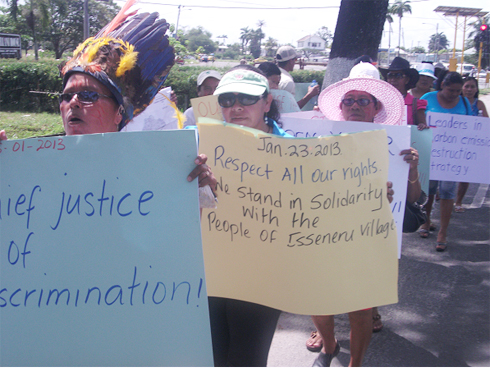Isseneru villagers yesterday staged a protest outside the Office of the President (OP) as they continued to voice their dissatisfaction over a recent court ruling that upheld a miner’s right to progress with operations on lands within the village.
Assembling along Vlissengen Road, over 80 protestors, including Amerindians who turned out to show their support for the Middle Mazaruni village, claimed that their rights as Guyanese citizens were violated by the ruling, while calling for a revision of the Amerindian Act.

“The Best Act?? You lied to us!” “Our land, Our life,” and “Respect all our rights,” were among the messages on placards carried by protestors, some of whom demonstrated with their faces painted while members of the police force looked on.
The legislation has come under scrutiny following the ruling last week by Justice Diana Insanally, who made orders granted to miner Joan Chang against the Isseneru Village Council and the Guyana Geology and Mines Commission (GGMC) binding. Members of the Village Council had claimed that the mining company was mining on titled lands without the council’s permission under the Amerindian Act and despite subsequent Cease Work Orders (CWOs) issued by the GGMC mining officer.
However, Justice Insanally pointed out in her ruling that by virtue of Chang being granted a licence to mine prior to the coming into operation of the Amerindian Act of 2006, the Village Council had no authority to stop the operation and the GGMC no authority to issue the CWOs.
The large crowd of protestors, who march back and forth along the road, said the demonstration was to show that they were not satisfied with the ruling of the court even as some pleaded with President Donald Ramotar to hear their plight. The protesters described themselves as victims of the law and contended that the ruling of the court has reduced them to mere squatters. “The court ruling refrains me from using my land. I’m a squatter now with no right,” one man said.
“We want our land! The court has ruled in favor of the miner and it seems like we don’t have rights! We want the president to know and recognise us,” another said, while charging that mining operations destroy the lands and kill their animals. “They kill our fishes and cut down our trees. How can we plant if they destroy it? This is our only living.”
Other protesters shouted that the Minister of Amerindian Affairs Pauline Sukhai had neglected them. “The minister has rejected our claim because she is not coming out of her office to represent us! She should be here protesting with us as our minister and a fellow Amerindian,” Jacelyne Joseph, a resident of Isseneru said.
The protestors emphasised that they were serious about their culture and their land and would continue to protest until someone answers their plight.
On Tuesday evening, President Ramotar and Minister Sukhai met with the council representatives and their attorney David James. Sukhai was quoted as saying by the Government Information Agency (GINA) that they would work together with respect to examining the case and consider appealing.
In a letter, published in Stabroek News’ January 24, 2013 edition, Chang’s lawyer Abiola Wong-Inniss noted that her client’s interest, which was by way of a claim licence, was in existence prior to 1989 and it was not open to the state when framing the provisions of the Amerindian Act to derogate from such rights. “Therefore, such rights were expressly excluded in the following terms, namely, “Save and except all lands legally held,” and such a provision conforms to the underlying intention of the rights afforded by Article 142 of the Constitution which provides protection from deprivation of property,” Wong-Inniss wrote.





